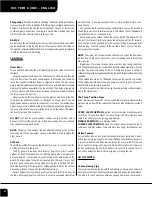
Example 1: If the Number 1 battery is low, place the
switch in the Number 2 position. Then start the
engine. Place switch in Number 1 position. This will
allow the engine alternator to recharge both batteries.
Example 2: If the Number 2 battery is low, place the
switch in the Number 1 position. Then start the
engine. This will allow the engine alternator to
recharge both batteries.
Note: When recharging a low battery, be sure to run the engine
for a sufficient amount of time to fully recharge the battery.
Note: Chaparral does not recommend any other settings than men-
tioned because of possible damage to batteries or engine alternator.
Electrolysis and Zinc Anodes
Many boaters are unaware of the problems associated with electrol-
ysis and how to properly address corrosion issues. Electrolysis is a
reaction between metal and electrical energy. Electrolysis occurs
when electrical current is "leaking" into the water, and can come
from a variety of things such as ship to shore power, sharing electri-
cal wires, old electrical devices in contact with the water, batteries in
boats, etc.
Electrolysis can also be caused by “stray currents” due to a fault in
an electrical item, even though correctly grounded.
Electrolysis/corrosion is a very real issue and expense for any
boater and boat owners must be aware of the proper protection and
maintenance. Corrosion will directly affect the performance of your
boat within a very short period of time.
It is the boat owner’s responsibility to check for and replace dam-
aged parts due to galvanic deterioration. Refer to your Chaparral
dealer to investigate the source of stray corrosive currents.
Zinc plates are installed on the outdrive and trim tabs to protect
underwater hardware on your boat. Zinc is less noble than copper
based alloys and aluminum used in underwater fittings; therefore, it
will deteriorate first and protect the more noble parts.
Zinc anodes generally require replacement about once a year, in
salt water areas, replace every six months. The need to replace
anodes more frequently may indicate a stray current problem within
the boat or at the slip or mooring. If zinc anodes are not replaced
annually, they may not be providing the necessary protection.
Note: Do not paint between the zinc and any metal it touches.
Do not paint over the zinc.
Placing a zinc in the water bonded to the metal outlet box on the
dock will reduce zinc loss on the boat. Do not connect this zinc to
the boat’s ground system.
Important: All electrically operated DC equipment and acces-
sories must be wired so that the ground polarity of each device
is the same as that of the battery. Chaparral boats have a nega-
tive ground system, which is recommended practice
throughout the marine industry. All metal items (fuel tanks,
underwater hardware) in the boat are connected to the zinc
anode by the green bonding wire.
Once a year
(Performed by a qualified marine technician)
•
Inspect boat receptacles for any signs of deterioration, including
cord wear, loose connections, signs of sparking or overheating
and bent or pitted blades. If there are any such signs, examine,
correct, and test the equipment or replace it.
3-3
CAUTION:
Replace zinc sacrificial anodes if they are cor-
roded 50% or more.
Содержание 2009 Sunesta Wide Tech 224
Страница 2: ......
Страница 4: ......
Страница 17: ...1 7...
Страница 18: ......
Страница 22: ......
Страница 24: ......
Страница 40: ...2 16...
Страница 48: ...3 8...
Страница 80: ...5 16...
Страница 98: ......
Страница 106: ......
Страница 112: ......
Страница 113: ...WIRING SCHEMATICS 12 12 1...
Страница 114: ...12 2...
Страница 115: ...12 3...
Страница 116: ...12 4...
Страница 117: ...12 5...
Страница 118: ...12 6...
Страница 119: ......
















































